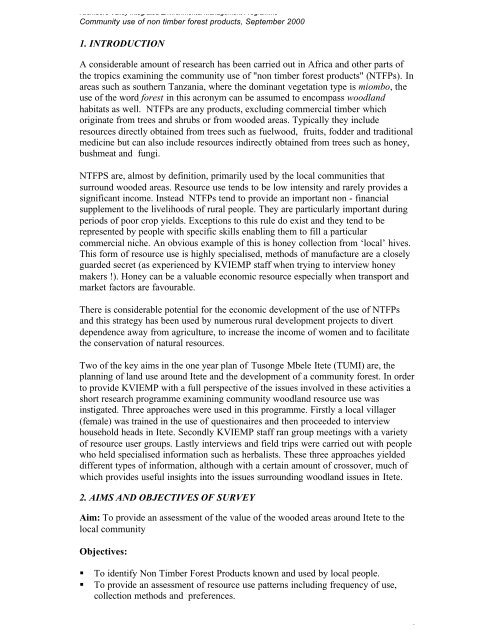Frontier Tanzania Savanna Research Programme Community use ...
Frontier Tanzania Savanna Research Programme Community use ...
Frontier Tanzania Savanna Research Programme Community use ...
Create successful ePaper yourself
Turn your PDF publications into a flip-book with our unique Google optimized e-Paper software.
Kilombero Valley Integrated Environmental Management <strong>Programme</strong><br />
<strong>Community</strong> <strong>use</strong> of non timber forest products, September 2000<br />
1. INTRODUCTION<br />
A considerable amount of research has been carried out in Africa and other parts of<br />
the tropics examining the community <strong>use</strong> of "non timber forest products" (NTFPs). In<br />
areas such as southern <strong>Tanzania</strong>, where the dominant vegetation type is miombo, the<br />
<strong>use</strong> of the word forest in this acronym can be assumed to encompass woodland<br />
habitats as well. NTFPs are any products, excluding commercial timber which<br />
originate from trees and shrubs or from wooded areas. Typically they include<br />
resources directly obtained from trees such as fuelwood, fruits, fodder and traditional<br />
medicine but can also include resources indirectly obtained from trees such as honey,<br />
bushmeat and fungi.<br />
NTFPS are, almost by definition, primarily <strong>use</strong>d by the local communities that<br />
surround wooded areas. Resource <strong>use</strong> tends to be low intensity and rarely provides a<br />
significant income. Instead NTFPs tend to provide an important non - financial<br />
supplement to the livelihoods of rural people. They are particularly important during<br />
periods of poor crop yields. Exceptions to this rule do exist and they tend to be<br />
represented by people with specific skills enabling them to fill a particular<br />
commercial niche. An obvious example of this is honey collection from ‘local’ hives.<br />
This form of resource <strong>use</strong> is highly specialised, methods of manufacture are a closely<br />
guarded secret (as experienced by KVIEMP staff when trying to interview honey<br />
makers !). Honey can be a valuable economic resource especially when transport and<br />
market factors are favourable.<br />
There is considerable potential for the economic development of the <strong>use</strong> of NTFPs<br />
and this strategy has been <strong>use</strong>d by numerous rural development projects to divert<br />
dependence away from agriculture, to increase the income of women and to facilitate<br />
the conservation of natural resources.<br />
Two of the key aims in the one year plan of Tusonge Mbele Itete (TUMI) are, the<br />
planning of land <strong>use</strong> around Itete and the development of a community forest. In order<br />
to provide KVIEMP with a full perspective of the issues involved in these activities a<br />
short research programme examining community woodland resource <strong>use</strong> was<br />
instigated. Three approaches were <strong>use</strong>d in this programme. Firstly a local villager<br />
(female) was trained in the <strong>use</strong> of questionaires and then proceeded to interview<br />
ho<strong>use</strong>hold heads in Itete. Secondly KVIEMP staff ran group meetings with a variety<br />
of resource <strong>use</strong>r groups. Lastly interviews and field trips were carried out with people<br />
who held specialised information such as herbalists. These three approaches yielded<br />
different types of information, although with a certain amount of crossover, much of<br />
which provides <strong>use</strong>ful insights into the issues surrounding woodland issues in Itete.<br />
2. AIMS AND OBJECTIVES OF SURVEY<br />
Aim: To provide an assessment of the value of the wooded areas around Itete to the<br />
local community<br />
Objectives:<br />
• To identify Non Timber Forest Products known and <strong>use</strong>d by local people.<br />
• To provide an assessment of resource <strong>use</strong> patterns including frequency of <strong>use</strong>,<br />
collection methods and preferences.<br />
4
















